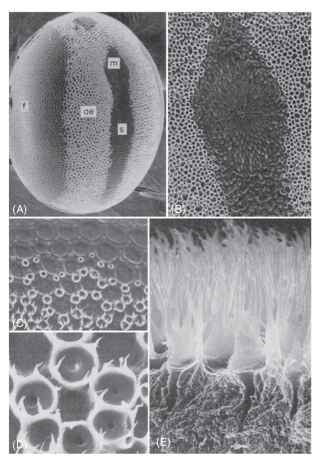The protective coverings females provide their eggs reflect the full range of environments exploited by insects. Egg coverings fall into two major categories: those produced by follicle cells and those produced by accessory glands of the reproductive tract. Follicle cells secrete the chorion, or insect eggshell. The design of the chorion is important in fertilization, egg respiration, and water balance. Coverings produced by accessory glands provide additional protection from the elements, predators, and parasites.
THE EGGSHELL
Layers of the Eggshell
As the oocyte develops, follicle cells secrete structural proteins, along with other substances, as layers. The making of insect eggshell has been best documented in the fruit fly Drosophila melanogaster. The vitelline envelope, sometimes considered to be the first layer of the chorion, is the first and innermost layer produced. Next, a layer of wax is secreted, giving the egg greater resistance to desiccation. Then, several more chorionic layers are produced, commonly with sheetlike inner and outer layers separated by a pillared region enclosing air spaces. In insects such as Odonata and Ephemeroptera, which lack accessory glands for producing additional secretions, follicle cells may also produce gelatinous or adhesive coatings. Figure 1 shows the chorionic structures of Antheraea polyphemus, the polyphemus moth.
Functions of the Eggshell
The eggshell is a layer of armor protecting the egg and developing embryo from the elements, predators, and parasites. Eggshell shape, texture, and color can also provide protection through camouflage and warning coloration.
The protection must be breached, however, to allow for vital functions. First, sperm must be able to enter and fertilize mature eggs. Micropyles, which are openings allowing sperm access to the egg

FIGURE 1 Chorionic structures of the polyphemus moth Antheraea polyphemus. (A) Regional differences in chorion structures. Note micropyle (m) and aeropyle (ae) regions. (B) Micropyle region magnified. (C-E) Aeropyle region.
interior, often have distinct architecture, such as the conical protrusion in D. melanogaster. Some insect eggs have multiple micropyles.
Second, the developing embryo is very active metabolically and must respire. Various architectural features of the chorion allow the embryo to exchange gases in both air and water. The interior chorion layer, with its pillared structure, harbors a thin layer of air that can connect directly to the atmosphere by openings termed aeropyles. In moist environments, when air trapped by the inner chorion cannot access atmospheric air directly, the trapped air layer functions as a plastron. Plastrons allow diffusion of gases between water and the air space based on differential partial pressures. The proportion of the egg surface that functions as plastron or aeropyle reflects moisture levels generally found in a particular habitat. To enhance respiratory capacity, eggshells may have extensions, called respiratory horns, that increase the surface area for gas exchange.
Third, some insect eggs are able to absorb environmental water to replace that lost by evaporation. Hydropyles, which are regions specialized for water uptake, may include chorionic layers in addition to the oocyte membranes interior to the vitelline envelope.
Finally, the embryo itself must be able to emerge from the eggshell when development is complete. Lines of weakness built into the eggshell, based on the interruption of some of the chorionic layers, create a “door,” or operculum, through which the first-stage larva can emerge.
OTHER EGG COVERINGS
The colleterial glands (based on colle from Greek for glue) are accessory glands of the female’s reproductive system that produce egg coatings. Most simply, glue is produced to attach eggs to a substrate. In addition, some coatings deter predators or parasites chemically.
Insects in the orthopteroid orders Blattodea, Mantodea, and Orthoptera, as well as some beetle taxa, secrete an egg case or pod surrounding the eggs, to give additional protection from desiccation and predation. As with eggshells, these egg casings must be constructed to allow respiration and hatching. In cockroach eggs, the air space surrounding each embryo opens into a ventilated air duct in the keel. In grasshoppers, the colleterial gland secretions are churned into a froth in which the eggs are suspended. The entire oviposition hole is filled with the frothy material, which then hardens to form a plug. Mantids produce a similar substance from their col-leterial glands, which they mold into an egg case that is attached to a flat surface or suitable vegetation.
Beetles are also known to produce egg cases, with the most complex occurring in the cassidine Chrysomelidae. Less complex ootheca have been reported in a variety of other beetle groups as well. Colleterial glands in hydrophilid beetles produce silk that is used to form a cocoon for the egg mass.
Various insect taxa use additional material to enhance protection for eggs. In some beetles, fecal material and/or secretions from anal glands apparently provide chemical defense. Some Lepidoptera use urticating (or irritating) hairs from the larval skin to protect eggs. As adult females emerge from the cocoons, they pick up discarded larval setae (hairs) with their anal tufts and later deposit them on eggs. Nonurticating adult scales, most commonly from the anal tuft, are also used by some species to create an effective physical barrier.
